|
|
Datalogic R Series
A lineup of very tough, all-aluminum, Windows CE-based vehicle mount computers
(by Conrad H. Blickenstorfer, photography by Carol Cotton -- view PDF version)
Unlike some rugged systems manufacturers that primarily offer notebooks or tablet computers running Windows XP or some other variant of a full-function desktop/notebook operating system, Datalogic primarily offers Windows CE-based handhelds, almost a dozen different models all in all. This means Datalogic cover the various needs of handheld computing customers but, until last year, they did not have platforms for customers who wanted to leverage their investment in Windows CE and CE.Net applications, but needed vehicle mount systems.
This changed in 2008 when Datalogic and Germany's DLoG struck an OEM partnership deal where DLoG would supply its X-series terminals to Datalogic. This fanless platform was originally designed to run Windows XP, XP Embedded or even Linux on low power Intel processors, but then complemented with Windows CE-based versions using the same 520MHz Marvell PXA270 application processor used in millions of handheld and embedded devices. This enabled Datalogic to expand and complement its lineup with a tried-and-true, mature platform available in three sizes with 7, 10.4 and 12.1 inch displays.
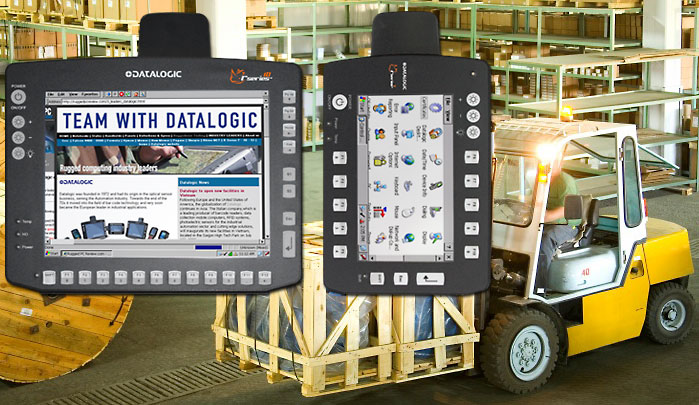
The Datalogic R Series 7 -- for when there isn't much room
The Datalogic R Series 7 is the smallest and lightest of the lineup, suitable for forklifts and other applications where space is at a premium. It measures roughly six by nine inches (without the protruding WiFi card/antenna cover) and is a bit over three inches thick. Weight doesn't matter all that much in a vehicle or fixed-mounted system, but the R7's relatively low weight of 5.5 pounds still comes in handy. The device, made entirely of aluminum, feels unbelievably solid, as if it were milled from a solid block of the metal. There are screw holes on the top, bottom and back for a variety of mounting systems. The device itself is designed for use in landscape mode.
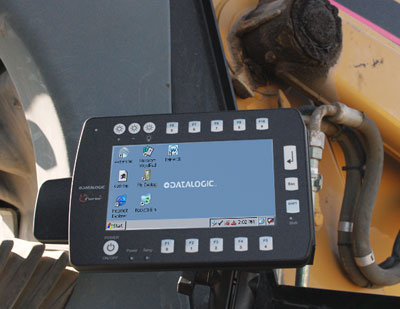 As the name implies, the R Series 7 uses a display that measures seven inches diagonally. It is a color TFT with wide-format 480 x 232 pixel resolution, a somehat unusual ratio best suited for custom applications. The display has a very bright 500 nits backlight and a resistive touch screen. Datalogic offers a variety of compact external keyboards with both ABCD and QWERTY layouts. Input can also be via touch in custom applications, or via onscreen keyboard. The R7 comes with the standard Windows CE pop-up keyboard and also with the more extensive My-T-Soft keyboard/input panel. As the name implies, the R Series 7 uses a display that measures seven inches diagonally. It is a color TFT with wide-format 480 x 232 pixel resolution, a somehat unusual ratio best suited for custom applications. The display has a very bright 500 nits backlight and a resistive touch screen. Datalogic offers a variety of compact external keyboards with both ABCD and QWERTY layouts. Input can also be via touch in custom applications, or via onscreen keyboard. The R7 comes with the standard Windows CE pop-up keyboard and also with the more extensive My-T-Soft keyboard/input panel.
As you can see on the pictures of the R Series 7, the computer has a number of membrane-style pushbuttons arranged around the display. On the R Series 7 they include power, brightness up and down, backlight on/off, enter, escape, and shift. There are also ten function keys that can be assigned, via the Datalogic Desktop Utility, actions and applications. The utility also lets you access certain admin functions, set authorized applications, set error redirection pages, and so on. Each key actually has a double function; in unshifted mode, the ten function keys work as numeric input keys.
From a technical standpoint, the R Series vehicle mounts are Windows CE 5.0-based systems using the 520MHz version of the Marvell XScale PXA270 processor. There are 128MB of RAM and Flash ROM each. A PC Card Type II slot is available for expansion as long as, per Datalogic information, no CF card is being used in the CF slot that sits underneath the PC Card slot. For connectivity, the R Series 7 has two standard DB9 serial ports. Our review unit came with a full USB port as well as a mini-A and a mini-B USB port. On the R Series 7, all ports are on the right side of the device, deeply recessed into the unit so that jacks and plugs do not get in the way. For wireless networking connectivity, there is 802.11b/g WiFi.
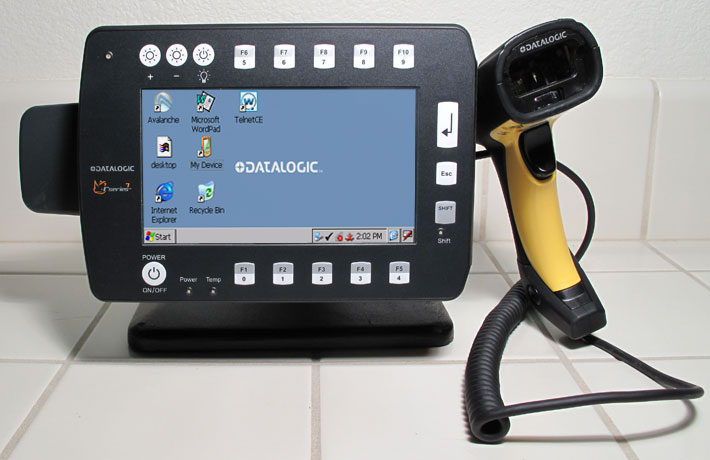
As a vehicle mount system, the R Series 7 is designed to run on 24/48 Volt DC. It can handle fairly significant voltage sags (up to 5 Volts), but there is no internal backup battery.
While the R Series 7 is basically just a smaller version of the R Series 10 and 12, its insides are quite different. The housing itself uses the same design, though, consisting of two halves made of solid aluminum. They are as thick and sturdy as an engine block and unlikely to ever break. A replaceable pressure seal ensures that the unit is waterproof. As is the case with the R 10, when opened, the two halves are loosely held together with two plastic hinges. That way, when you undo the four thick Allen wrench screws and pry the unit apart, the heavy halves won't fall and rip off wires and cables. As is, there's actually only a single ribbon cable between the two halves. Like the R10, the R7 is extremely neat and clean inside, and had a number of extra connectors. There is a roughly 5-1/2 x 4-1/4 system board and a separate power converter board. The system board has both a PC Card slot and a CF card slot underneath it. Both can physically accommodate a card at the same time.
Like the R Series 10, our R Series 7 had a Summit Data Communication SDC-CF10G 802.11g Compact Flash Radio Module. The bump you see in the picture of the R Series 7 covers the CF card that extends a bit through the opening, and a special antenna. Below you can see the Datalogic R Series 7 from the front and all sides.
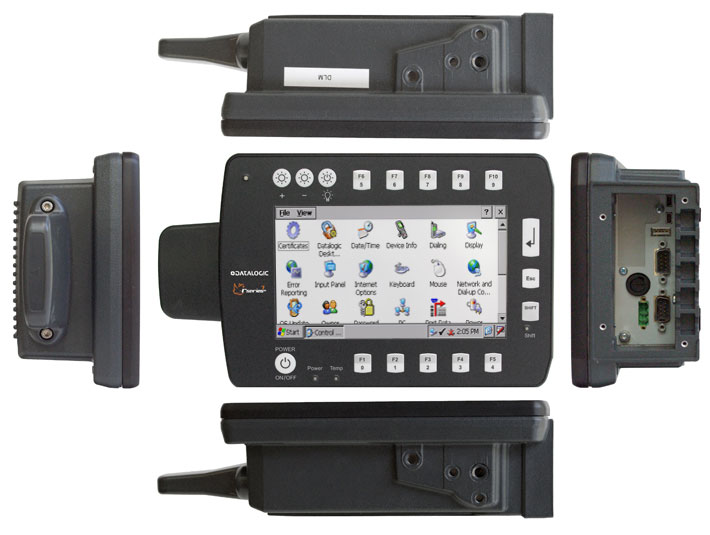
The Datalogic R Series 10 -- for when full SVGA resolution matters
The Datalogic R Series 10 is the mid-size version suitable for applications that require a full SVGA display in a compact package. It measures roughly eleven by nine inches (without the protruding WiFi card/antenna cover) and is about 3-1/2 inches thick. The R Series 10 weighs about nine pounds. Like the smaller model, the R10 is made entirely of aluminum and feels about as solid as it gets, again with a feeling as if it were milled from a solid block of the metal. There are screw holes on the left and right sides as well as on the back for a variety of mounting systems. The device itself is designed for use in landscape mode.
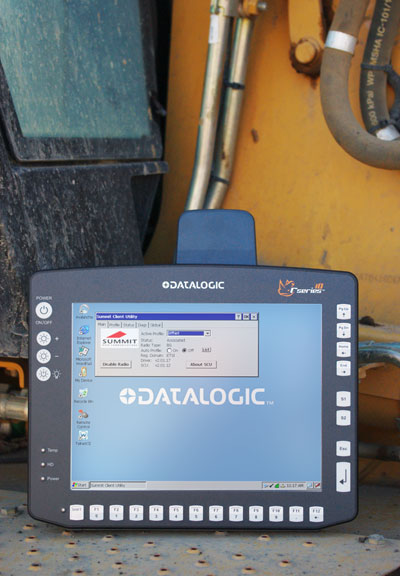 As you can see on the pictures, the R Series 10 also has a number of membrane-style pushbuttons arranged around the display. On the larger R Series 10 they include power, brightness up and down, backlight on/off, enter, escape, shift, page up/down, home, end. You get two extra function keys for a total of 12. They can be assigned, via the Datalogic Desktop Utility, actons and applications. In unshifted mode they let you enter numbers 0-9 as well as period and baackspace The utility also users lets access certan admin functions, set authorized applications, set error redirection pages, and so on. In addition, there are function keys S1 and S2 which are not present in the smaller unit. As you can see on the pictures, the R Series 10 also has a number of membrane-style pushbuttons arranged around the display. On the larger R Series 10 they include power, brightness up and down, backlight on/off, enter, escape, shift, page up/down, home, end. You get two extra function keys for a total of 12. They can be assigned, via the Datalogic Desktop Utility, actons and applications. In unshifted mode they let you enter numbers 0-9 as well as period and baackspace The utility also users lets access certan admin functions, set authorized applications, set error redirection pages, and so on. In addition, there are function keys S1 and S2 which are not present in the smaller unit.
As stated above, from a technical standpoint, all R Series vehicle mounts are Windows CE 5.0-based systems using the 520MHz version of the Marvell XScale PXA270 processor. There are 128MB or RAM and Flash ROM each. A PC Card Type II slot is available for expansion as long as, per Datalogic information, no CF card is being used in the CF slot that sits underneath the PC Card slot. For connectivity, the R Series 10 has two standard DB9 serial ports. Our review unit came with a full USB port as well as a mini-A and a mini-B USB port. On the R Series 10, all ports are on the bottom side of the device, deeply recessed into the unit so that jacks and plugs do not get in the way. For wireless networking connectivity, there is 802.11b/g WiFi.
The R Series 10 housing consists of two halves, both milled from solid aluminum. The halves are extremely rigid and strong. They are held together by six thick Allen-wrench screws. An O-ring pressure seal around the perimeter of the housing provides a watertight seal. Inside the housing is the power converter and a 5-1/2 x 5-1/2 circuit board with a small daughterboard on top of it. Everything is neat and clean, with cables and wires color-coded and long enough so they won't pull out during service or reconfiguration. There are quite a few unused connectors (Heating, audio, PIC prog, etc.), as we'd expect in a highly configurable platform. Mounted on the motherboard are both a PC Card slot an a CF Card slot, on top of one another. The card slots are externally accessible through a cutout in the aluminum housing.
Our R Series 10 had a Summit Data Communication SDC-CF10G 802.11g Compact Flash Radio Module. The bump you see in the picture of the R Series 10 covers the CF card that extends a bit through the opening, and a special antenna.
Below is a composite picture of the Datalogic R Series 10 from the front and all sides.
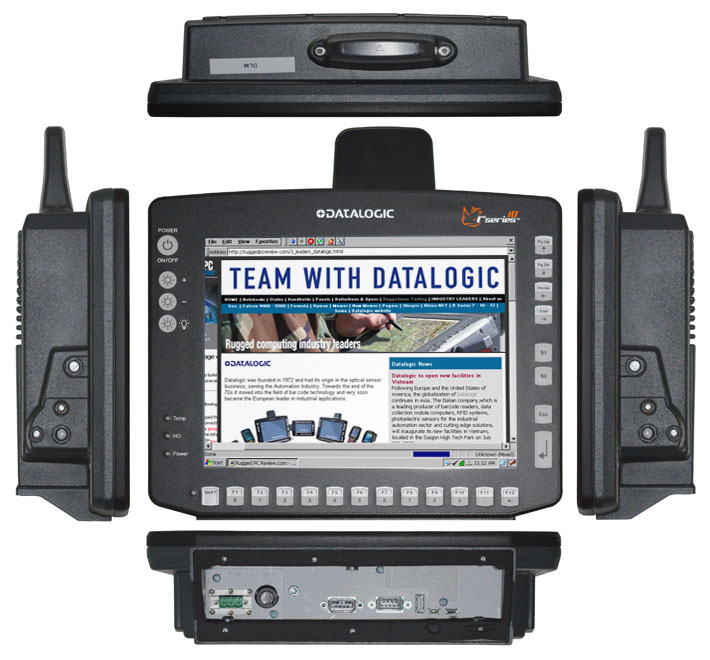
The Datalogic Wavelink alliance
In 2008, Wavelink Corporation and Datalogic Mobile formed a strategic alliance that brought, at no additional cost, pre-licensed Wavelink Terminal Emulation software to Datalogic mobile devices. Wavelink Avalanche is pre-licensed on all Datalogic Windows Mobile and Windows CE devices, including the R Series. When users purchase a device and register it with Wavelink they even get one-year of free maintenance. In essence, Wavelink terminal emulation adds some of the most popular emulation types including 5250, 3270, VT100, VT110, and VT220. It also allows the simultaneous running of multiple emulation sessions, with easy navigation between them.
The R Series also includes Wavelink Avalanche, which is a mobile device management solution that provides complete visibility and control of mobile units from a central console. Companies that have a large number of mobile systems in the field can use it for the configuration, deployment, and management of all those mobile devices. This can streamline operations, enforce wireless network and security configurations, and just generally make sure that policies are adhered to. Avalanche allows to define and control what each user or user group is authorized to access and manage by assigning rights according to job functions or locations.
Ruggedness
The Datalogic R Series are extremely solid and rugged machines. Their fanless housings are designed specifically to handle the shock and vibration encountered in rigid suspension vehicles.
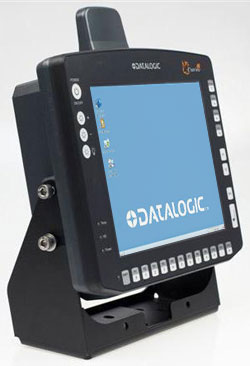 The listed environmental testing results include both US and European standard testing. There is no drop spec as that usually doesn't pertain to fixed-mount units. Shock and vibration testing results are given as per the European EN 60721-3 standards. The listed environmental testing results include both US and European standard testing. There is no drop spec as that usually doesn't pertain to fixed-mount units. Shock and vibration testing results are given as per the European EN 60721-3 standards.
The R Series is heavily sealed and can handle a wide 32 to 122 degree Fahrenheit operating temperature range. Note that an optional heater that allows operation down to -22 degrees Fahrenheit is available for the R Series 10 and 12, but not for the Series 7 model. Essentially, that means that extended freezer applications require the 10 or 12-inch models.
With regard to sealing against solids and liquids, Datalogic supports IP65, IP66 and IP67. What does that all mean? The first number refers to protection against solids. "5" means protection against dust but with limited ingress whereas "6" means total protection against dust. The second number means protection against liquids. "5" means protection against low pressure jets from all directions, "6" means protection against "heavy seas," and "7" means protection even against limited immersion.
A wide variety of mounting solutions are available for the R Series, including sun visor mounts, mounts for the optional barcode reader, swiveling brackets, and the uniquely versatile RAM Mount solutions.
A word about the operating system
For those not familiar with the Windows CE system used in all versions of the R Series, here's a brief overview: Since Windows CE is an embedded OS, it contains only a small subset of all the functions and functionality of a full OS. The idea is to include exactly what a user needs, as opposed to the everything-and-the-kitchen-sink approach of a full desktop OS like Vista. Microsoft makes certain application programs available for Windows CE, and depending on the version those may include limited versions of most of the familiar Office apps as well as image viewers and other more consumer-oriented applications.
It gets a bit confusing here because at some point Microsoft began making a distinction between consumer-oriented Pocket PCs and industrial handhelds. The Pocket PC side of things evolved into Windows Mobile, the rather polished OS found on many smartphones today. Windows CE concentrated on being a tool for jobs. Companies such as Datalogic often offer both Windows Mobile and Windows CE on a platform since customers may have different requirements. The R Series, however, is strictly Windows CE.
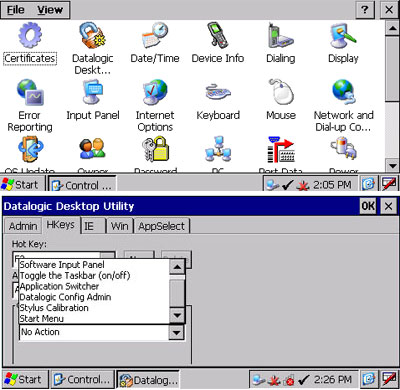 Why Windows CE 5.0 instead of one of the most recent variants of Windows Mobile with all its bells and whistles and prettier user interface? Because Windows CE remains a very compact, very efficient and scalable operating system that was designed for a broad range of embedded systems and products and has plenty of programming support and a rich subset of Microsoft Win32 APIs. Why Windows CE 5.0 instead of one of the most recent variants of Windows Mobile with all its bells and whistles and prettier user interface? Because Windows CE remains a very compact, very efficient and scalable operating system that was designed for a broad range of embedded systems and products and has plenty of programming support and a rich subset of Microsoft Win32 APIs.
Further, CE's multi-threaded, multi-tasking, fully preemptive OS environment was targeted from the start specifically toward hardware with limited resources. Windows CE supports a rich subset of Microsoft Win32 APIs and several additional programming interfaces. As a longtime supporter of Windows CE for industrial applications, Datalogic has considerable experience with the platform. With the Datalogic R Series, there is no need to create onboard drivers or using the Platform Builder to create a CE image; Datalogic supplies that, and also a series of enhancement and utilities to make the creation of customized software even simpler.
The screen shots on the right show the control panel and the DataLogic Desktop Utility on the 7-inch model's 480 x 232 pixel display.
While Windows CE can include multimedia, PIM applications and communications tools, that is not the primary purpose here. Our R Series 7 and 10 testers came with essentially just four of the common applications--Microsoft WordPad, email, Pocket Internet Explorer, and the Media Player. However, there were no fewer than 26 control panels and utilities to configure and fine-tune the device, and a typical customer device will probably run some custom-designed application software.
Summary: Datalogic R Series
The Datalogic R Series is a trio of vehicle/fixed-mount computers that differ primarily in the size of their displays: 7.0, 10.4 and 12.1 inches. All three models are extremely solid and feel as if they were milled from solid blocks of aluminum. 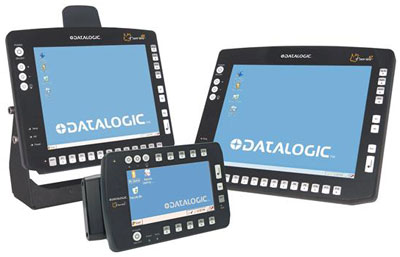 All three run the Windows CE 5.0 operating system, providing access to a vast library of Windows CE applications and utilities, as well as leveraging customer investment in software and development tools already in use for CE-based handhelds.
All three run the Windows CE 5.0 operating system, providing access to a vast library of Windows CE applications and utilities, as well as leveraging customer investment in software and development tools already in use for CE-based handhelds.
The purpose of the R Series is to bring data collection and decision support computing to warehouse and shop floor management applications where they are used for receiving, put-away, picking and shipping. The devices can be operated with an external keyboard, via touch/stylus, or via an onscreen keyboard. Datalogic offers tethered or wireless scanners for rapid data capture. All units have programmable membrane pushbuttons surrounding the displays.
All three models have bright touch screens, but they differ in resolution. The R Series 7's display offers 480 x 232 pixel resolution whereas the 10 and 12-inch models have full 800 x 600 pixel SVGA screens. That is obviously a big difference and may drive selection of either the small unit or one of the larger ones.
For software development, there is the standard Windows CE SDK as well as Wavelink terminal emulation, and a variety of Datalogic and Wavelink utilities. Mounting is facilitated by a variety of solutions, including sun visor mounts, mounts for the optional barcode reader, swiveling brackets, and the versatile RAM Mount solutions.
Datalogic R Series highlights:
- A trio of extremely solid vehicle-mount computers for warehousing applications
- Three models with different display sizes: 7, 10.4 and 12.1 inches
- Based on tried-and-true Marvell PXA270 processor and well supported Windows CE 5.0 OS
- Large array of programmable membrane buttons
- A variety of different mounting solutions
- Availability of external keyboard and Datalogic scanners
- Good onboard connectivity
- Good ruggedness and sealing
- Leverages existing investment in Windows CE handhelds
But keep in mind:
- Strictly vehicle/fixed mount units without internal battery
- Large resolution difference between Series 7 (480 x 232) and Series 10 and 12 (800 x 600)
– Conrad H. Blickenstorfer, July 2009
|
Datalogic R Series Specifications
|
| Added/changed |
Added 7/2009
|
| Type |
Rugged vehicle mount computer
|
| Processor |
520MHz Marvell XScale PXA270 |
| OS |
Windows CE 5.0 |
| RAM/ROM |
128MB SDRAM, 128MB Flash |
| Display |
R Series 7: 7.0-inch, 480 x 232 pixel, 500 nits backlight
R Series 10: 10.4-inch, 800 x 600 pixel, 230 or 400 nits backlight
R Series 12: 12.1-inch, 800 x 600 pixel, 350 nits backlight |
| Digitizer/Pens |
resistive touchscreen/1 |
| Keyboard |
Optional external keyboards with ABCD or QWERTY layouts |
| Slots |
1 PC Card Type I/II, 1 CF Card, both externally accessible |
| Housing |
Aluminum |
| Temperature |
32 to 122 degree Fahrenheit; optional heater for -22 to 122F operation (not available in R Series 7) |
| Humidity |
10-90% at 104F, non-condensing |
| Shock/Vibration |
Class 5M3 according to EN 60721-3-5 (5 hours 3.6g effective noise and 36 vibrations with 30g peaks) and US Highway Truck per MIL-STD 810F (3 hours 1g effective noise and 600 vibrations with 20g peaks) |
| Enclosure Class |
IP65, IP66 and IP67 for water and dust resistance |
| Size (inches) |
R Series 7: 9.0 x 6.2 x 3.3 inches
R Series 10: 11.0 x 8.9 x 3.4 inches
R Series 12: 12.6 x 10.3 x 4.0 inches |
| Weight |
R Series 7: 5.5 pounds
R Series 10: 8.8 pounds
R Series 12: 10.2 pounds |
| Power |
R Series 7: 24/48 VDC, 36 W, galvanically isolated, voltage sags up to 5 VDC can be handled for up to 20 sec.
R Series 10/12: 24/48 VDC, 60 W and 100 W, galvanically isolated, voltage sags up to 10 VDC can be handled for up to 20 sec. |
| Communication |
Summit Data Communication SDC-CF10G 802.11g Compact Flash Radio Module |
| Interface |
2 RS232, 2 USB 2.0 (2 host or 1 host and 1 client) |
Price |
Inquire |
| Contact |
Datalogic Mobile www.mobile.datalogic.com -- 800-310-8300, 541-743-4900 |
|
|







